Development of Hollow Steel Ball Macro-Encapsulated PCM for Thermal Energy Storage Concrete
Abstract
:1. Introduction
2. Results and Discussion
2.1. Thermal Properties and Reliability of PCM-HSB
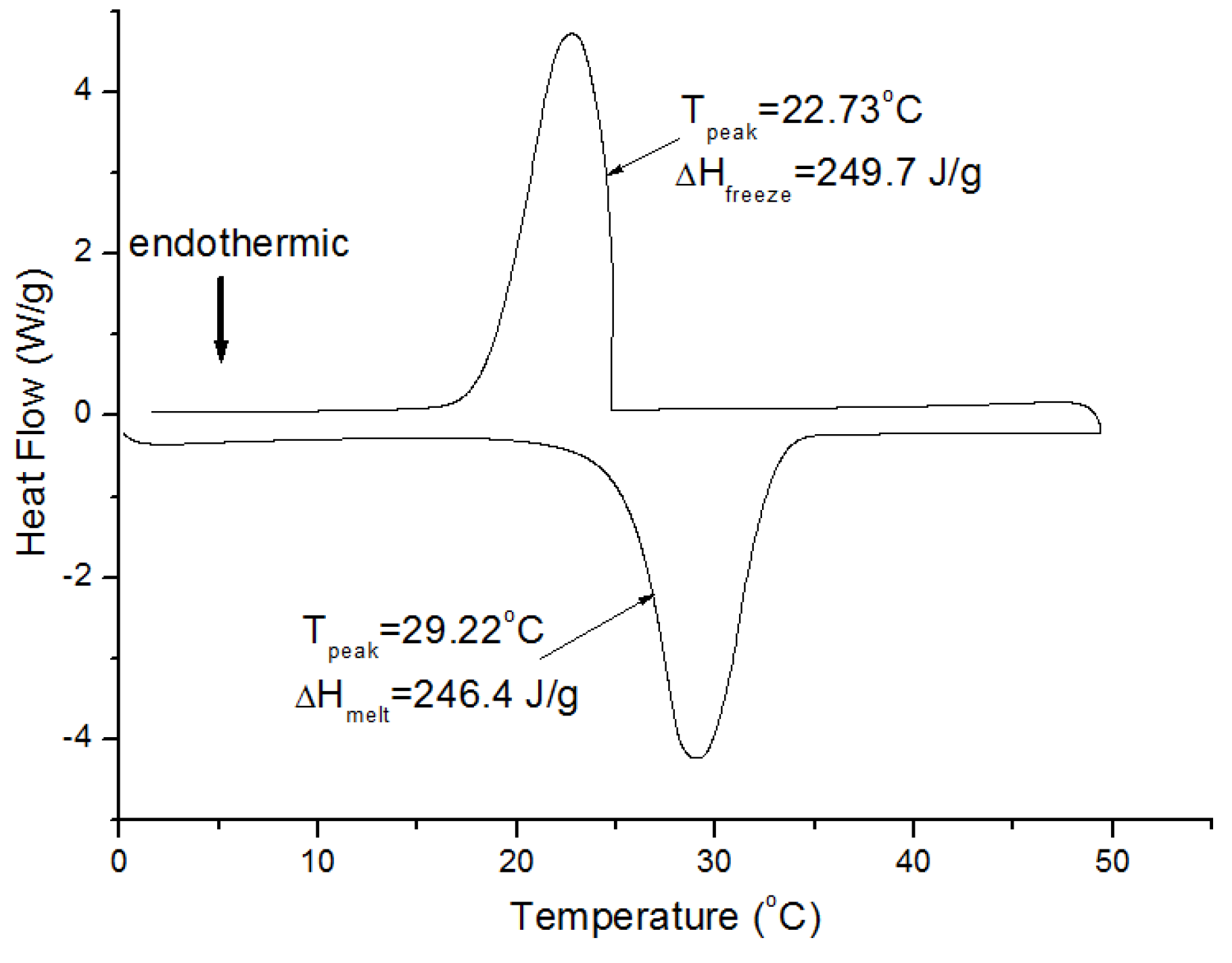
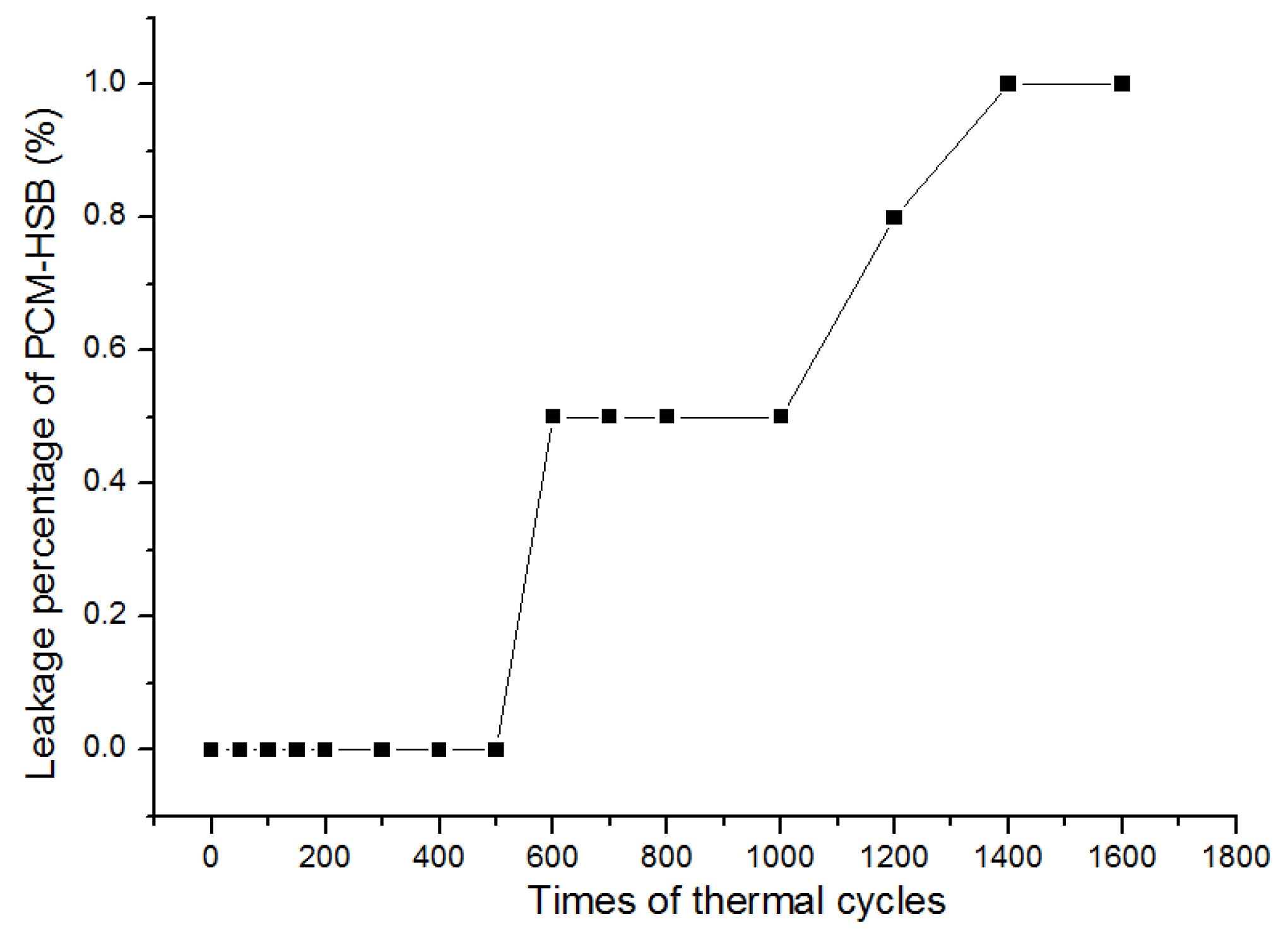
2.2. Thermal Performance of PCM-HSB Concrete
| Sample No. | The Maximum Temperature (°C) | Maximum Temperate Difference | Time of Peak Temperature (Delay Time) | ||||
|---|---|---|---|---|---|---|---|
| OS | IS | Indoor | OS | IS | Indoor | ||
| NC | 55.3 | 50.7 | 41.2 | 14.1 | 15:00 | 15:01(+0:01) | 15:01(+0:01) |
| SC-25% | 39.0 | 36.2 | 30.7 | 8.3 | 15:01 | 15:05(+0:04) | 15:06(+0:05) |
| SC-50% | 36.9 | 32.9 | 28.9 | 8.0 | 14:59 | 15:04(+0:05) | 15:06(+0:07) |
| SC-75% | 36.4 | 32.5 | 28.5 | 7.9 | 15:01 | 15:07(+0:06) | 15:09(+0:08) |
| SC-100% | 35.1 | 30.7 | 27.6 | 7.5 | 15:00 | 15:07(+0:07) | 15:09(+0:09) |
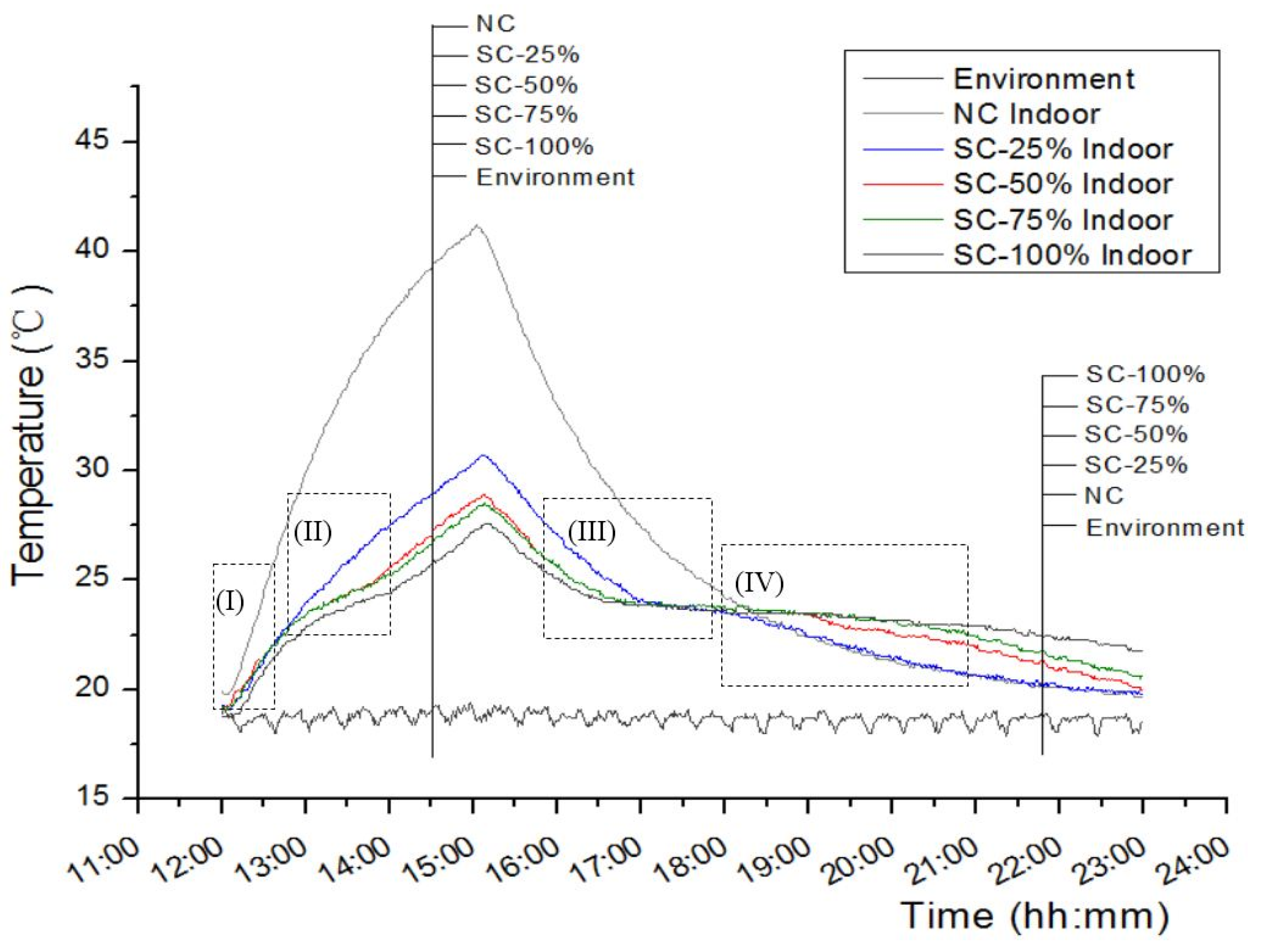
2.3. Mechanical Properties
| Sample No. | 28 d Compressive Strength (MPa) | Reduction of Compressive Strength in Respect to the Control (%) |
|---|---|---|
| NC (control) | 48.8 | - |
| SC-25% | 39.7 | 19% |
| SC-50% | 33.8 | 31% |
| SC-75% | 29.6 | 39% |
| SC-100% | 22.0 | 55% |
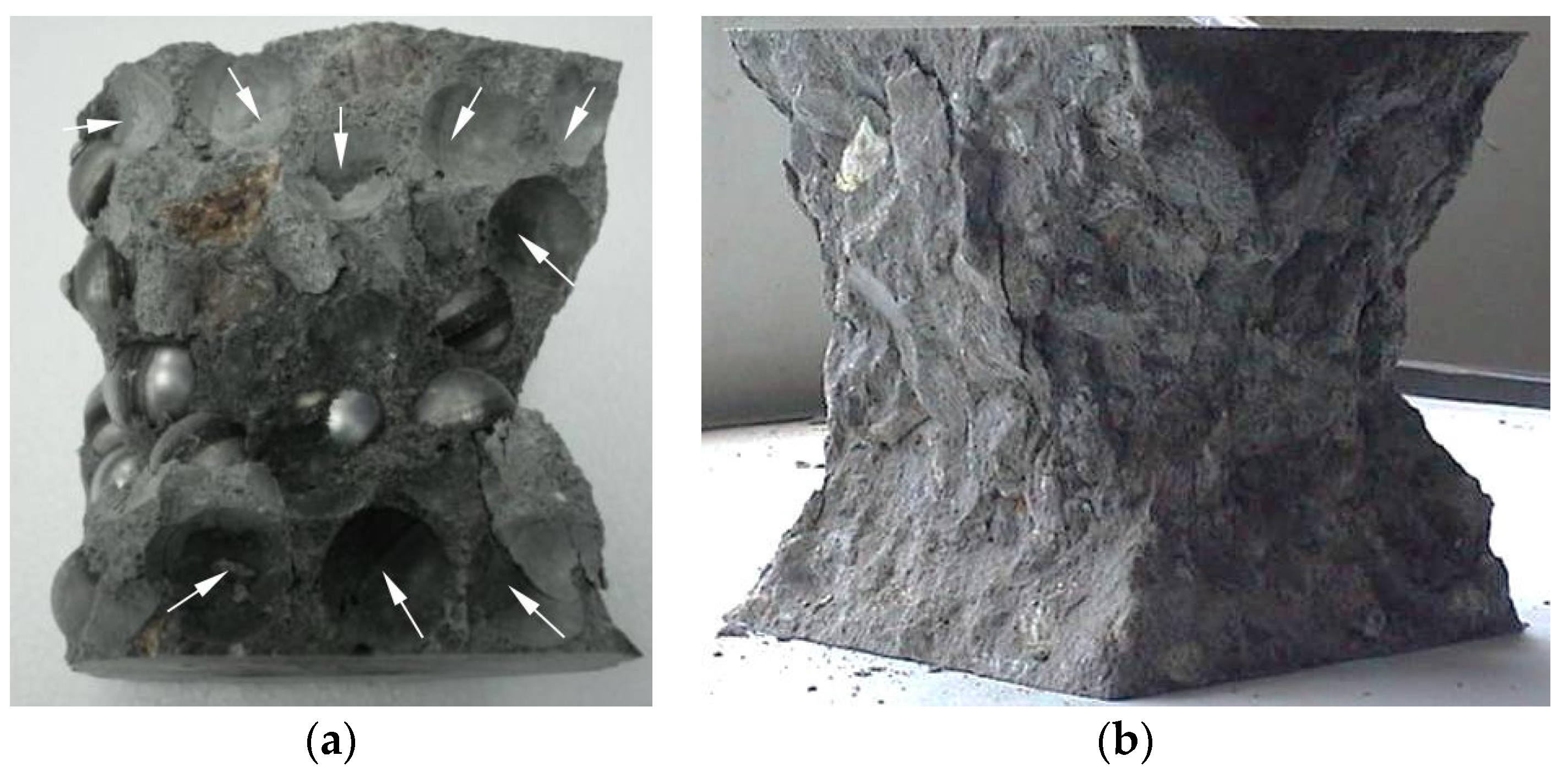
3. Materials and Methods
3.1. Materials Required for the Development of Macro-Encapsulated PCM-HSB
| Appearance | Relative Density (g/cm3) | Melting Temperature (°C) | Latent Heat Thermal Energy (J/g) |
|---|---|---|---|
| Colorless liquid | 0.78 | 27.1 | 249.7 |
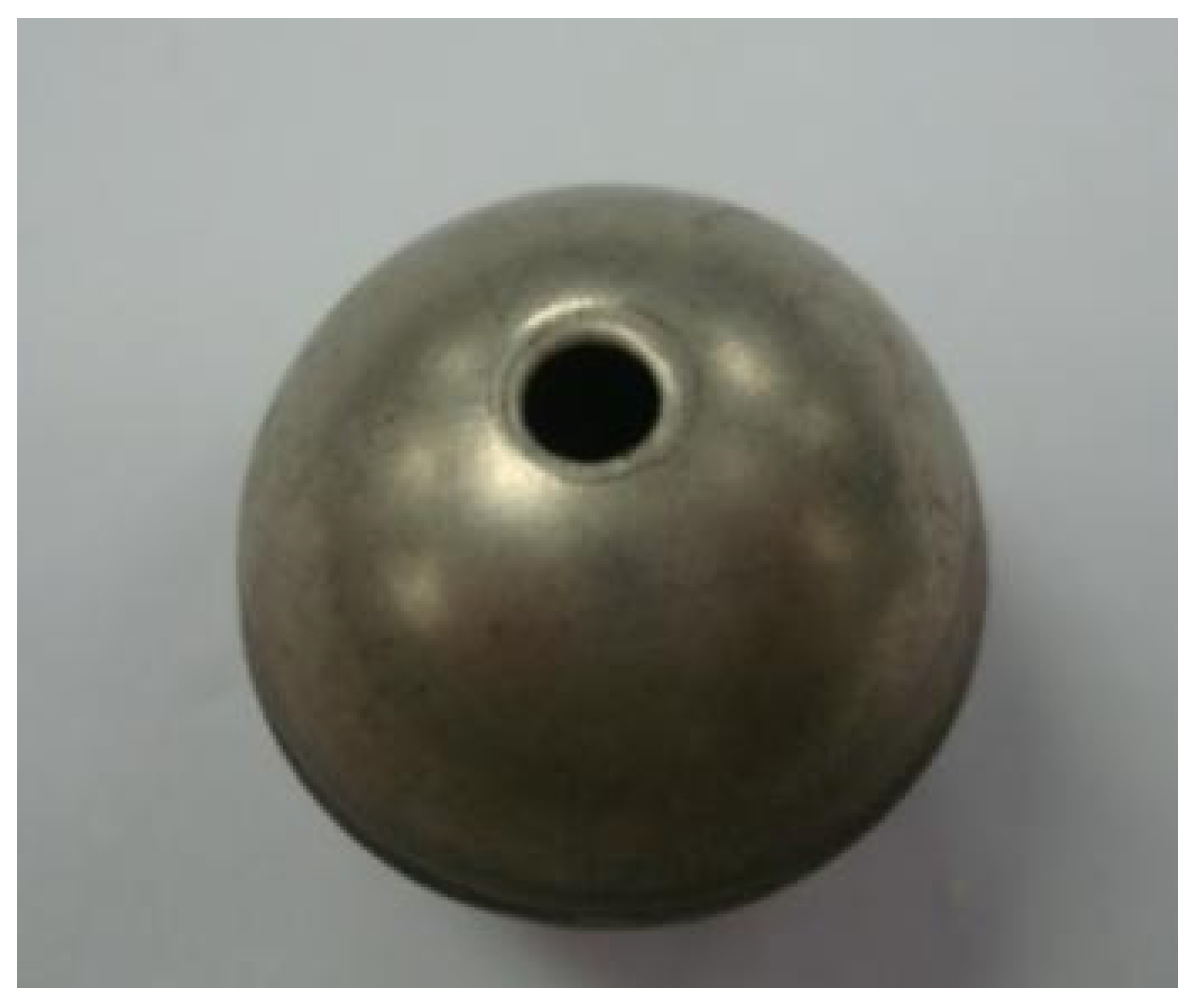
| Inner Diameter (mm) | Outer Diameter (mm) | Hole Diameter (mm) | Apparent Density (kg/m3) |
|---|---|---|---|
| 20.6 | 22 | 2.7 | 1039 |
3.2. Preparation of Macro-Encapsulated PCM-HSB

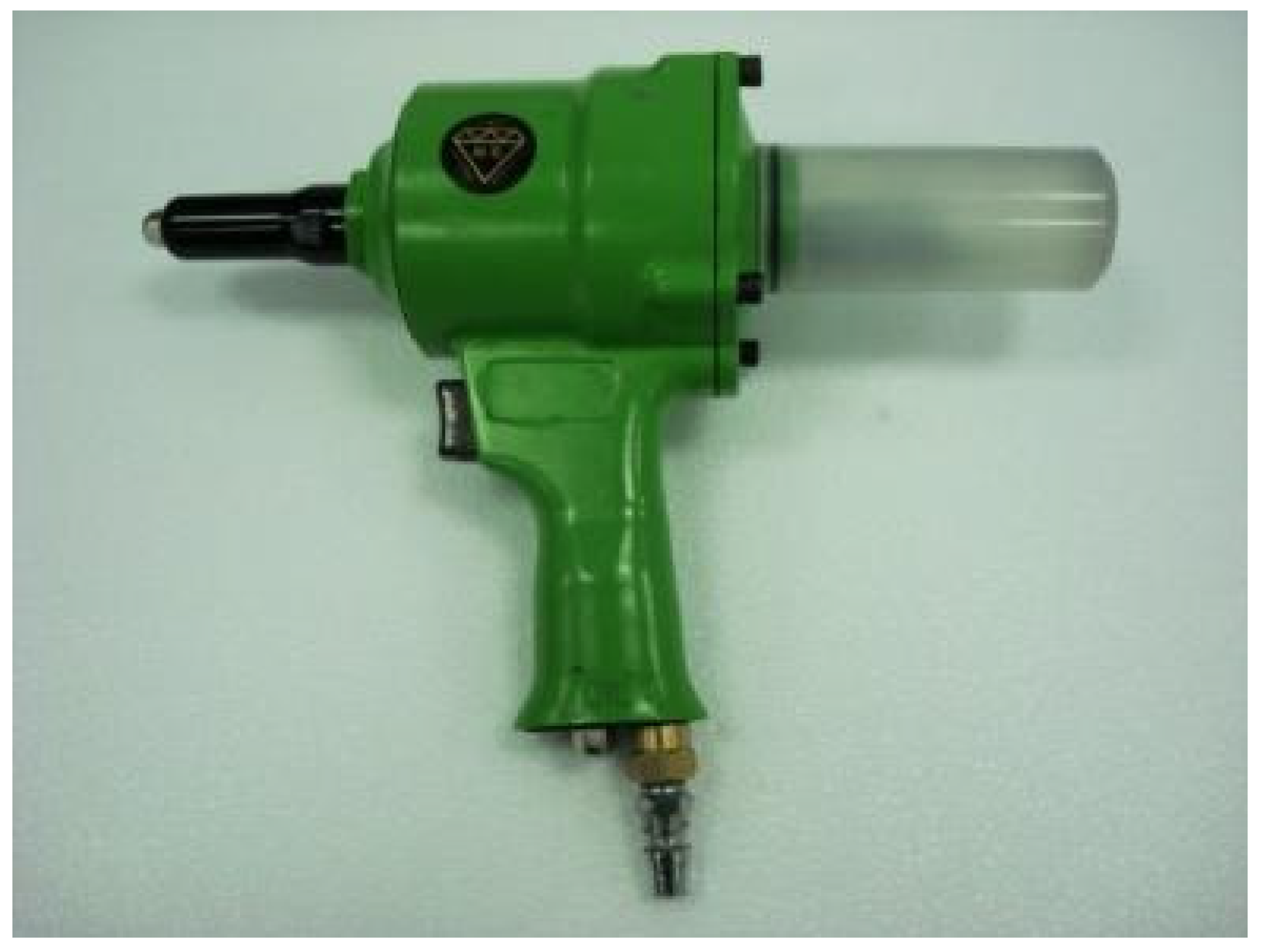
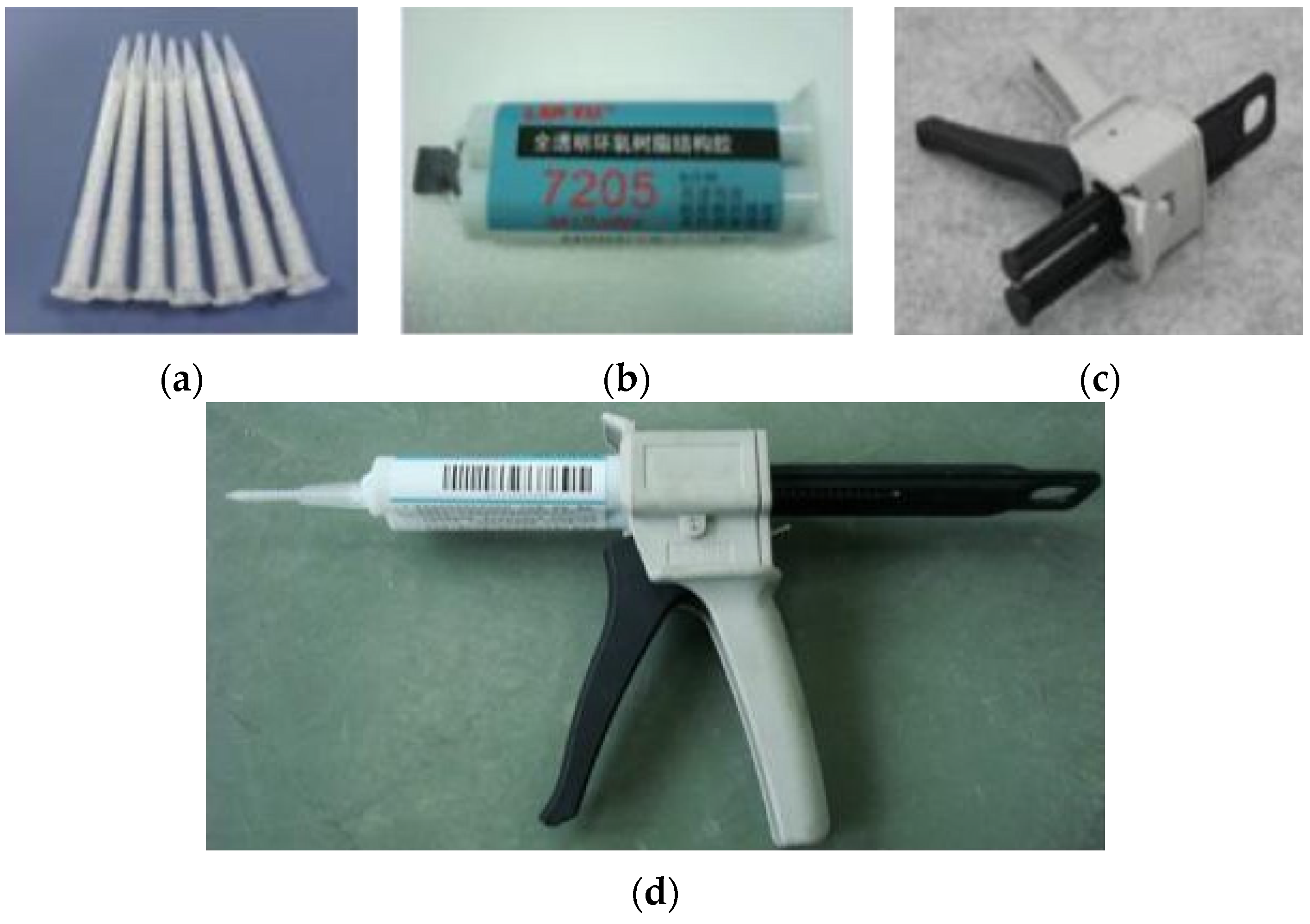
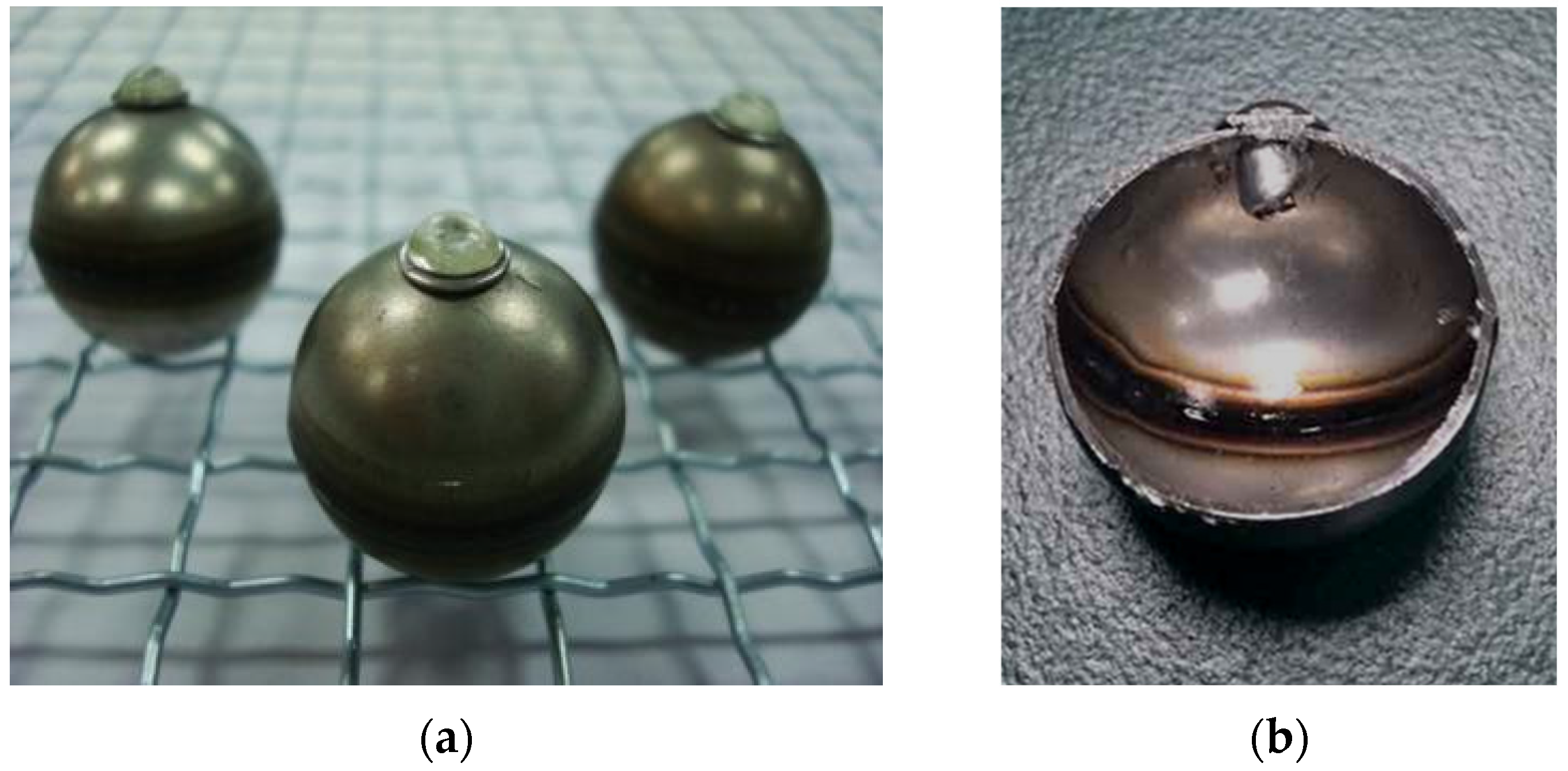
3.3. Test Method for the Characterization of Macro-Encapsulated PCM-HSB
3.3.1. Thermal Capacity of PCM-HSB
3.3.2. Thermal Cycle Test
3.4. Materials and Mix Proportion for Concrete with PCM-HSB
| Aggregate Type | Apparent Density (kg/m3) | Size (mm) |
|---|---|---|
| Coarse Aggregate | 2600 | 14–26 |
| PCM-HSB | 1670 | 22 |
| Type | Cement (kg) | Water (kg) | Sand (kg) | Gravel (kg) | PCM-HSB (kg) | Admixture (kg) |
|---|---|---|---|---|---|---|
| NC | 400 | 140 | 787 | 1092 | 0 | 4 |
| SC-25% | 400 | 140 | 787 | 819 | 175 | 4 |
| SC-50% | 400 | 140 | 787 | 546 | 351 | 4 |
| SC-75% | 400 | 140 | 787 | 273 | 526 | 3.5 |
| SC-100% | 400 | 140 | 787 | 0 | 701 | 3.5 |
3.5. Concrete Mixing
3.6. Test Methods for Determining the Properties of PCM-HSB Concrete
3.6.1. Compressive Strength Test
3.6.2. Thermal Performance of PCM-HSB Concrete Panel Indoor Test
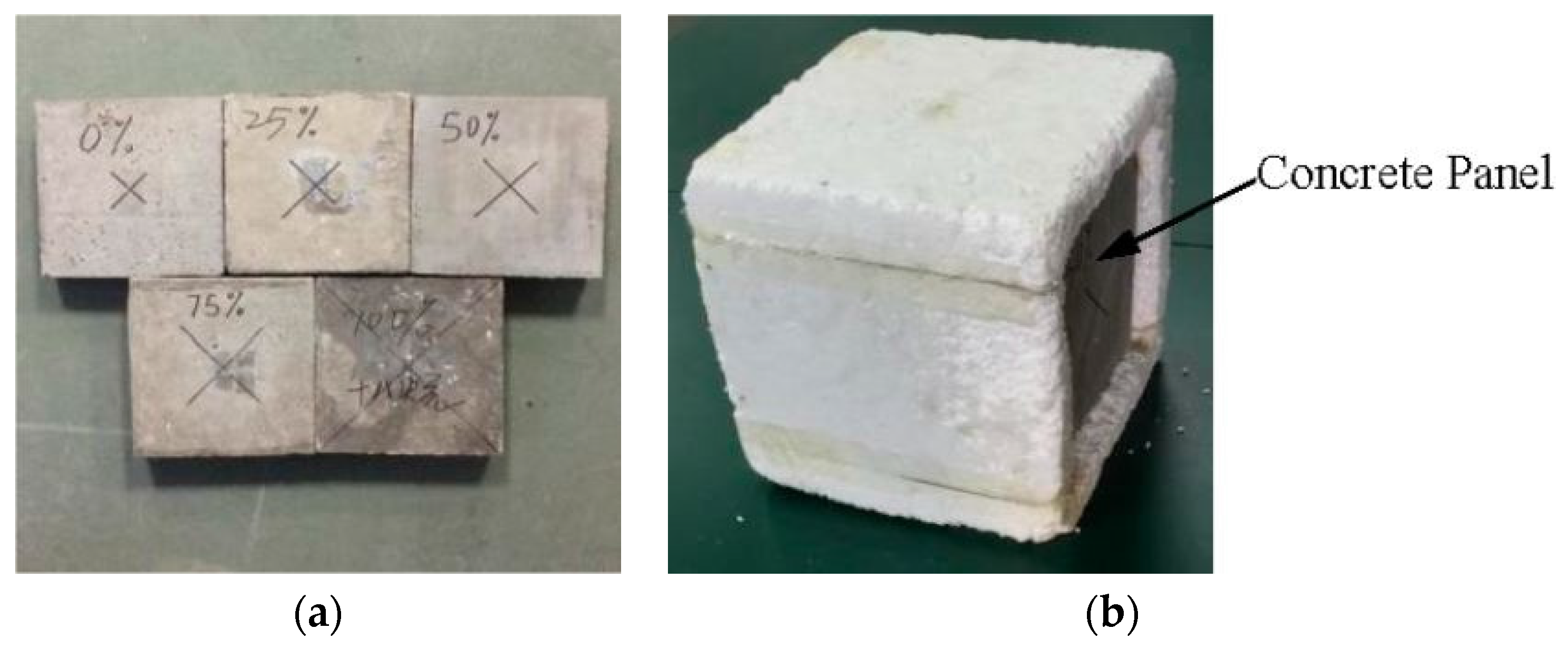

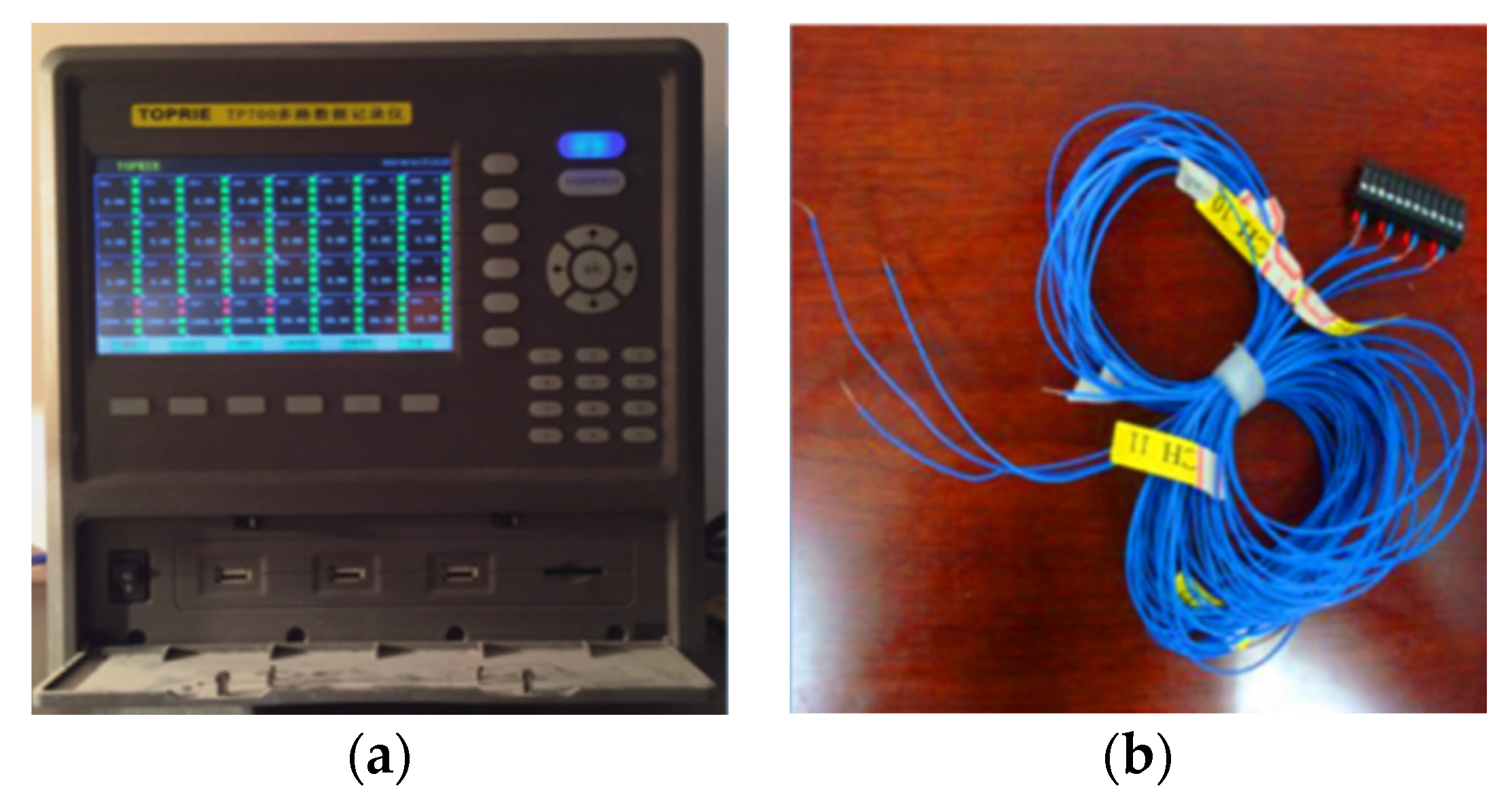
4. Conclusions
- (1)
- Each HSB was found to carry up to 80.3% of PCM by mass. The leakage of PCM from the sealed HSB was found to be less than 1% after 1600 cycles of thermal test. The use of a hollow steel ball (HSB) is believed to be an effective macro-encapsulation method to carry PCM, as the thermal conductivity and reliability of the storage system can be enhanced. With such high reliability, PCM-HSB is believed to have a great potential for long-term application in building.
- (2)
- The compressive strength of PCM-HSB concrete decreased with the increase in PCM-HSB content in the mix. The strength of SC-100% was found to be 22 MPa which is suitable for use as structural materials in construction industry.
- (3)
- From the self-designed thermal performance setup, it can be concluded that concrete panels incorporated with macro-encapsulated PCM-HSB functions to reduce the peak indoor air temperature and the fluctuation of indoor temperature can be very effective in transferring the heating and cooling loads away from the peak demand times. The significance of these functions was increased with the increase in PCM-HSB contents. In summary, macro-encapsulated PCM-HSB can improve the thermal performance of building materials, especially during the summer, in which the temperature is well above the phase change temperature of the macro-encapsulated PCM.
Acknowledgments
Author Contributions
Conflicts of Interest
References
- Cabeza, L.F.; Castell, A.; Barreneche, C.; de Gracia, A.; Fernández, A.I. Materials used as PCM in thermal energy storage in buildings: A review. Renew. Sustain. Energy Rev. 2011, 15, 1675–1695. [Google Scholar] [CrossRef]
- Álvarez, S.; Cabeza, L.F.; Ruiz-Pardo, A.; Castell, A.; Tenorio, J.A. Building integration of PCM for natural cooling of buildings. Appl. Energy 2013, 109, 514–522. [Google Scholar] [CrossRef]
- Pérez, G.; Coma, J.; Solé, C.; Castell, A.; Cabeza, L.F. Green roofs as passive system for energy savings when using rubber crumbs as drainage layer. Energy Procedia 2012, 30, 452–460. [Google Scholar] [CrossRef]
- Cot-Gores, J.; Castell, A.; Cabeza, L.F. Thermochemical energy storage and conversion: A-state-of-the-art review of the experimental research under practical conditions. Renew. Sustain. Energy Rev. 2012, 16, 5207–5224. [Google Scholar] [CrossRef]
- Baetens, R.; Jelle, B.P.; Gustavsen, A. Phase change materials for building applications: A state-of-the-art review. Energy Build. 2010, 42, 1361–1368. [Google Scholar] [CrossRef]
- Yang, J.; Zhao, C.Y. Solidification analysis of a single particle with encapsulated phase change materials. Appl. Ther. Eng. 2013, 51, 338–346. [Google Scholar] [CrossRef]
- Zhang, D.; Li, Z.; Zhou, J.; Wu, K. Development of thermal energy storage concrete. Cement Concrete Res. 2004, 34, 927–934. [Google Scholar] [CrossRef]
- Meshgin, P.; Xi, Y. Multi-scale composite models for the effective thermal conductivity of PCM-concrete. Construct. Build. Mater. 2013, 48, 371–378. [Google Scholar] [CrossRef]
- Qiu, X.; Li, W.; Song, G.; Chu, X.; Tang, G. Microencapsulated n-octadecane with different methylmethacrylate-based copolymer shells as phase change materials for thermal energy storage. Energy 2012, 46, 188–199. [Google Scholar] [CrossRef]
- Alawadhi, E.M. Using phase change materials in window shutter to reduce the solar heat gain. Energy Build. 2012, 47, 421–429. [Google Scholar] [CrossRef]
- Chou, H.-M.; Chen, C.-R.; Nguyen, V.-L. A new design of metal-sheet cool roof using PCM. Energy Build. 2013, 57, 42–50. [Google Scholar] [CrossRef]
- Oliver, A. Thermal characterization of gypsum boards with PCM included: Thermal energy storage in buildings through latent heat. Energy Build. 2012, 48, 1–7. [Google Scholar] [CrossRef]
- Alkan, C.; Sarı, A.; Karaipekli, A.; Uzun, O. Preparation, characterization, and thermal properties of microencapsulated phase change material for thermal energy storage. Solar Energy Mater. Solar Cells 2009, 93, 143–147. [Google Scholar] [CrossRef]
- Arce, P.; Castellón, C.; Castell, A.; Cabeza, L.F. Use of microencapsulated PCM in buildings and the effect of adding awnings. Energy Build. 2012, 44, 88–93. [Google Scholar] [CrossRef]
- Cui, H.; Memon, S.A.; Liu, R. Development, mechanical properties and numerical simulation of macro encapsulated thermal energy storage concrete. Energy Build. 2015, 96, 162–174. [Google Scholar] [CrossRef]
- Shi, X.; Memon, S.A.; Tang, W.; Cui, H.; Xing, F. Experimental assessment of position of macro encapsulated phase change material in concrete walls on indoor temperatures and humidity levels. Energy Build. 2014, 71, 80–87. [Google Scholar] [CrossRef]
- Memon, S.A.; Cui, H.Z.; Zhang, H.; Xing, F. Utilization of macro encapsulated phase change materials for the development of thermal energy storage and structural lightweight aggregate concrete. Appl. Energy 2015, 139, 43–55. [Google Scholar] [CrossRef]
- Kheradmand, M.; Azenha, M.; Aguiar, J.L.B.D.; Krakowiak, K.J. Thermal behavior of cement based plastering mortar containing hybrid microencapsulated phase change materials. Energy Build. 2014, 84, 526–536. [Google Scholar] [CrossRef]
- Memon, S.; Liao, W.; Yang, S.; Cui, H.; Shah, S. Development of composite PCMs by incorporation of paraffin into various building materials. Materials 2015, 8, 499–518. [Google Scholar] [CrossRef]
- Cui, H.; Liao, W.; Memon, S.; Dong, B.; Tang, W. Thermophysical and mechanical properties of hardened cement paste with microencapsulated phase change materials for energy storage. Materials 2014, 7, 8070–8087. [Google Scholar] [CrossRef]
- Hong, L.; Gu, X.; Lin, F. Influence of aggregate surface roughness on mechanical properties of interface and concrete. Construct. Build. Mater. 2014, 65, 338–349. [Google Scholar] [CrossRef]
- Zhang, J.; Yan, H.; Chen, S.L.; Wang, X.M.; Gu, Z.D. The preparation and properties of the low melting point microencapsulated paraffin insulation mortar. Appl. Mech. Mater. 2011, 71–78, 4835–4838. [Google Scholar] [CrossRef]
- Memon, S.A.; Cui, H.; Lo, T.Y.; Li, Q. Development of structural-functional integrated concrete with macro-encapsulated PCM for thermal energy storage. Appl. Energy 2015, 150, 245–257. [Google Scholar] [CrossRef]
- Standard Specifications for Structural Concrete; ACI Committee 301, ACI 301-96; American Concrete Institute (ACI): Farmington Hills, MI, USA, 1996.
- Cui, H.; Liao, W.; Mi, X.; Lo, T.Y.; Chen, D. Study on functional and mechanical properties of cement mortar with graphite-modified microencapsulated phase-change materials. Energy Build. 2015, 105, 273–284. [Google Scholar] [CrossRef]
- Common Portland Cement; GB175-2007; China National Standardization Management Committee: Beijing, China, 2007.
- Methods of Testing Cements—Determinations of Strength; ISO R679; International Organization for Standardization: Geneva, Switzerland, 1989.
- Specification for Aggregates from Natural Sources for Concrete; BS 882:1992; British Standard: London, UK, 1992.
- Standard Test Method of Mechanical Properties on Ordinary Concrete; GB/T 50081-2002; Ministry of Housing and Urban-Rural Development of the People’s Republic of China (MOHURD): Beijing, China, 2002.
- Xu, B.; Li, Z. Paraffin/diatomite composite phase change material incorporated cement-based composite for thermal energy storage. Appl. Energy 2013, 105, 229–237. [Google Scholar] [CrossRef]
© 2016 by the authors; licensee MDPI, Basel, Switzerland. This article is an open access article distributed under the terms and conditions of the Creative Commons by Attribution (CC-BY) license (http://creativecommons.org/licenses/by/4.0/).
Share and Cite
Dong, Z.; Cui, H.; Tang, W.; Chen, D.; Wen, H. Development of Hollow Steel Ball Macro-Encapsulated PCM for Thermal Energy Storage Concrete. Materials 2016, 9, 59. https://doi.org/10.3390/ma9010059
Dong Z, Cui H, Tang W, Chen D, Wen H. Development of Hollow Steel Ball Macro-Encapsulated PCM for Thermal Energy Storage Concrete. Materials. 2016; 9(1):59. https://doi.org/10.3390/ma9010059
Chicago/Turabian StyleDong, Zhijun, Hongzhi Cui, Waiching Tang, Dazhu Chen, and Haibo Wen. 2016. "Development of Hollow Steel Ball Macro-Encapsulated PCM for Thermal Energy Storage Concrete" Materials 9, no. 1: 59. https://doi.org/10.3390/ma9010059






